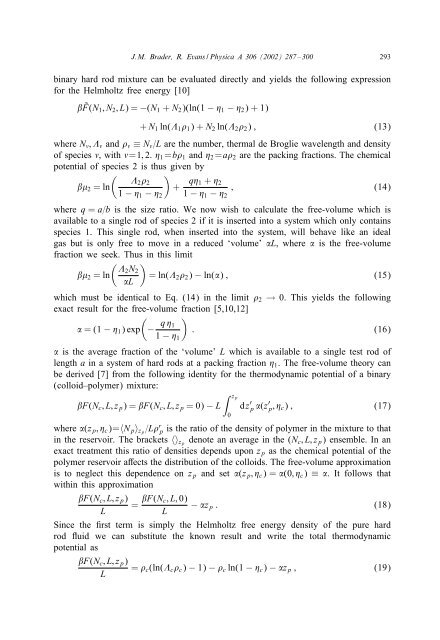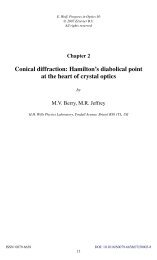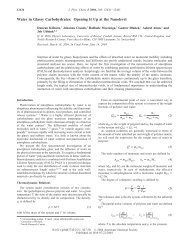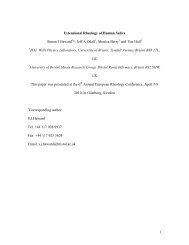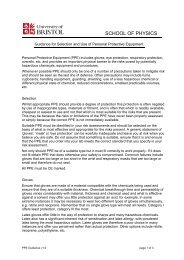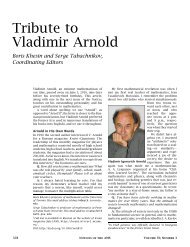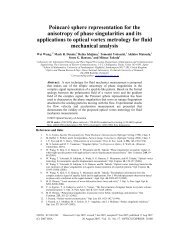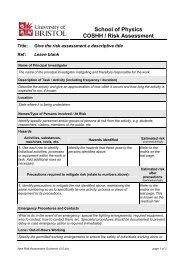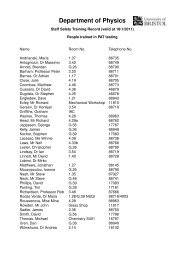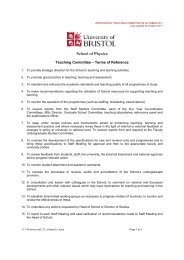An exactly solvable model for a colloidâpolymer ... - bristol.ac.uk
An exactly solvable model for a colloidâpolymer ... - bristol.ac.uk
An exactly solvable model for a colloidâpolymer ... - bristol.ac.uk
You also want an ePaper? Increase the reach of your titles
YUMPU automatically turns print PDFs into web optimized ePapers that Google loves.
J.M. Brader, R. Evans / Physica A 306 (2002) 287 – 300 293<br />
binary hardrodmixture can be evaluateddirectly andyields the following expression<br />
<strong>for</strong> the Helmholtz free energy [10]<br />
˜F(N 1 ;N 2 ;L)=−(N 1 + N 2 )(ln(1 − 1 − 2 )+1)<br />
+ N 1 ln( 1 1 )+N 2 ln( 2 2 ) ; (13)<br />
where N ; and ≡ N =L are the number, thermal de Broglie wavelength and density<br />
of species , with =1; 2. 1 =b 1 and 2 =a 2 are the p<strong>ac</strong>king fr<strong>ac</strong>tions. The chemical<br />
potential of species 2 is thus given by<br />
( )<br />
2 2<br />
2 =ln<br />
+ q 1 + 2<br />
; (14)<br />
1 − 1 − 2 1 − 1 − 2<br />
where q = a=b is the size ratio. We now wish to calculate the free-volume which is<br />
available to a single rodof species 2 if it is insertedinto a system which only contains<br />
species 1. This single rod, when inserted into the system, will behave like an ideal<br />
gas but is only free to move in a reduced ‘volume’ L, where is the free-volume<br />
fr<strong>ac</strong>tion we seek. Thus in this limit<br />
( )<br />
2 N 2<br />
2 =ln =ln( 2 2 ) − ln() ; (15)<br />
L<br />
which must be identical to Eq. (14) in the limit 2 → 0. This yields the following<br />
ex<strong>ac</strong>t result <strong>for</strong> the free-volume fr<strong>ac</strong>tion [5,10,12]<br />
(<br />
=(1− 1 ) exp − q )<br />
1<br />
: (16)<br />
1 − 1<br />
is the average fr<strong>ac</strong>tion of the ‘volume’ L which is available to a single test rodof<br />
length a in a system of hardrods at a p<strong>ac</strong>king fr<strong>ac</strong>tion 1 . The free-volume theory can<br />
be derived [7] from the following identity <strong>for</strong> the thermodynamic potential of a binary<br />
(colloid–polymer) mixture:<br />
F(N c ;L;z p )=F(N c ;L;z p =0)− L<br />
∫ zp<br />
0<br />
dz ′ p (z ′ p; c ) ; (17)<br />
where (z p ; c )=〈N p 〉 zp =L r p is the ratio of the density of polymer in the mixture to that<br />
in the reservoir. The br<strong>ac</strong>kets 〈〉 zp denote an average in the (N c ;L;z p ) ensemble. In an<br />
ex<strong>ac</strong>t treatment this ratio of densities depends upon z p as the chemical potential of the<br />
polymer reservoir aects the distribution of the colloids. The free-volume approximation<br />
is to neglect this dependence on z p andset (z p ; c )=(0; c ) ≡ . It follows that<br />
within this approximation<br />
F(N c ;L;z p )<br />
L<br />
= F(N c;L;0)<br />
L<br />
− z p : (18)<br />
Since the rst term is simply the Helmholtz free energy density of the pure hard<br />
roduidwe can substitute the known result andwrite the total thermodynamic<br />
potential as<br />
F(N c ;L;z p )<br />
= c (ln( c c ) − 1) − c ln(1 − c ) − z p ; (19)<br />
L


